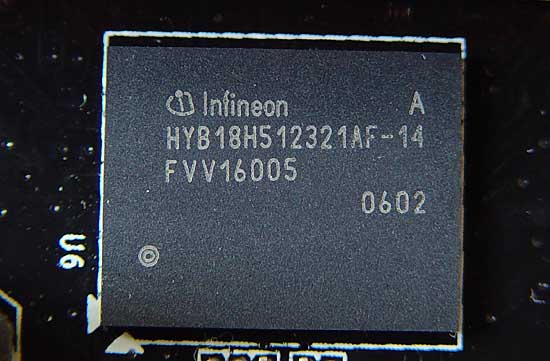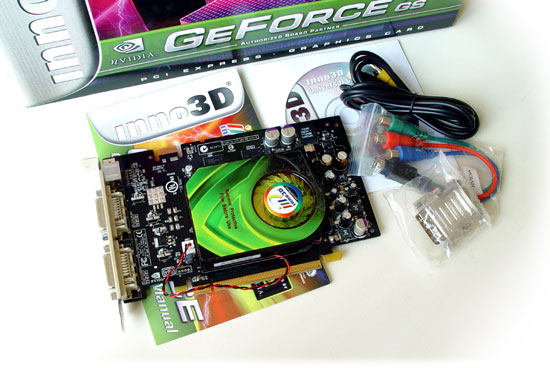Page 2
Back in March I went nuts to see that there finally was a new mid-range product launch with a sweet performance boost over the previous generation mid-range products. Low and midrange products always sell the best. They also offer you more bang for your bucks and often are very tweakable to squeeze some more performance out of them. Both the GeForce 7600 GS and GT are very competitive products in the mid-range market. I guarantee it.
The graphics core of today's tested product is armed with the development codename G73, the chip again was made on the newer 90nm fabrication process. For a mid-range product it has a rather large transistor count, no less than 177 million transistors can be found on the GeForce 7600 GS/GT silicon.
The "GST" as InnoVision calls it has 12 pixel pipelines running at a 500 MHz frequency with five active vertex processors. Also the product has eight ROPs. The memory however is still 128-bit whereas I hoped it would have been boosted to 256-bit. But it's really fast clocked memory namely 1400 MHz (2x700) and that is looking to be quite okay in my eyes.
The card is targeted at a very wide audience with a sales price of roughly 160 EUR/USD. This product is a 256MB version as mid-range is moving onto that amount of memory
Just like the 6600 GT the 7600 GT has SLI support, and since it's a Series 7 product you can expect dual-link DVI for extremely high resolution gaming up-to 2560x1600 (XHD as the industry would love to call that = Extreme High Definition). Plus, all the sweetness in the form of HDR support and that all important Shader Model 3.
So let me recap what this "GST" product precisely is .. basically this is a considerably faster than default clocked GeForce 7600 GS with GT memory. This placed the product performance wise above the GS level and close to the GT level, hence the name GST. It's not a bad name to be honest. It's a hybrid on a black PCB ! And that my friends can make this a very interesting product.
Why ? Well the GeForce 7600 GS set as an NVIDIA rule runs at 400 MHz accessing its memory at a 800 MHz (2x400 MHz DDR) frequency.
The GeForce 7600 GST from Inno3D runs it's core frequency at 500 MHz and accesses its memory at 1.4 GHz (700 MHz DDR) which are almost the same specs as GeForce 7600 GT (which runs at 560 MHz) and also accesses its memory at 1.4 GHz.

1000 : 1.4ns = a nominal 714 MHz memory
Furthermore there is no distinct difference between the GST and the GT. Both products have 12 Pixel pipelines. The GeForce 7600 GST guarantees to bring you a performance level very close to the GeForce 7600 GT but simply is a notch cheaper .. and that's not a bad place to be in.
Please focus on the chart below where I cite the more important specifications. Highlighted in light blue you'll notice the products specs.
| 400MHz | 800MHz | ||||||||||||||||||||||||||||||||||||||||||||||||||||||||||||||||||||||||||||
| GeForce 7300 GT | 8 | 5 | 128-bit | GDDR2/256MB | 350MHz | 667MHz | ||||||||||||||||||||||||||||||||||||||||||||||||||||||||||||||||||||||||
|
GeForce 6800 Ultra |
16 |
6 |
256-bit |
GDDR3/256MB |
400MHz |
1100MHz | ||||||||||||||||||||||||||||||||||||||||||||||||||||||||||||||||||||||||
|
GeForce 6800 GT |
16 |
6 |
256-bit |
GDDR3/256MB |
350MHz |
1000MHz | ||||||||||||||||||||||||||||||||||||||||||||||||||||||||||||||||||||||||
| GeForce 6800 GS PCX | 12 | 5 | 256-bit | GDDR3/128/256MB | 425MHz | 1000MHz | ||||||||||||||||||||||||||||||||||||||||||||||||||||||||||||||||||||||||
| GeForce 6800 GS AGP | 12 | 5 | 256-bit | GDDR3/128/256MB | 350MHz | 1000MHz | ||||||||||||||||||||||||||||||||||||||||||||||||||||||||||||||||||||||||
|
GeForce 6800 |
12 |
5 |
256-bit |
GDDR/128MB |
325MHz |
700MHz | ||||||||||||||||||||||||||||||||||||||||||||||||||||||||||||||||||||||||
|
GeForce 6800 LE |
8 |
4 |
256-bit |
GDDR/128MB |
320MHz |
700MHz | ||||||||||||||||||||||||||||||||||||||||||||||||||||||||||||||||||||||||
| GeForce 6600 GT | 8 | 3 | 128-bit | GDDR3/128/256MB | 500MHz | 1000MHz | ||||||||||||||||||||||||||||||||||||||||||||||||||||||||||||||||||||||||
| GeForce 6600 | 8 | 3 | 128-bit | GDDR/128MB | 300MHz | 275(550) | ||||||||||||||||||||||||||||||||||||||||||||||||||||||||||||||||||||||||
| GeForce 6200 | 4 | 3 | 64-bit | GDDR/128MB/256MB | 300MHz | 275(550) | ||||||||||||||||||||||||||||||||||||||||||||||||||||||||||||||||||||||||
As you can see Inno3D did some important things with this 7600 GST, it has a faster clock on both memory and core which brings the product VERY close to the more expensive 7600 GT, so this product is obviously all about value.
The Inno3D bundle
Now we always mention what toffee you get included in the box. Obviously the card with faster core, the faster memory and all that made on a cool looking black PCB. That's pretty much it though as you can't seriously expect much more in the box for the 160 EUR you have to pay for this card.
Notable is the fact that it has two Dual DVI output (analog DVI/VGA dongle included). Furthermore you'll find a driver CD, a video out-to-component (3-way RCA) adaptor for HD components TV connection and a Video cable. It's adequate to get you connected and for the money this bundle is absolutely nothing to be ashamed about as this product is all about pricing.

Shader Model 3 & HDR
If we say "Series 7 product" it means that you will have no doubt heard the terms "Vertex Shader" and "Pixel Shader". The step from 2.0 to 3.0 was a small one and most Shader Model 2.0 games can easily be upgraded to Model 3.0, which can bring more performance to that gaming experience. DirectX 9 was recently updated and we are going to see more and more support for 3.0 Shaders.
Is SM 3.0 technology a huge visual advantage over 2.0? Nope, not even the slightest bit. Yet any technological advantage is always welcome and preferred over a previous generation's development. What you need to remember about Shaders 3.0 is that it can and will be used only in several critical places where it can give a performance boost and graphics cards are all about performance my friends. Both ATI and NVIDIA now offer Shader Model 3 support in their new products. GeForce Series 6 and newer models and for ATI their X1000 series and newer models.
Another big trendy implementation that will bring games closer to a movie like quality experience is HDR.
Both ATI and NVIDIA
have been focusing extremely hard on HDR. They put a lot of money into their technology to support HDR in the best possible way and they should as it just is a fantastic effect that brings so much more to the your gameplay experience. HDR is something you all know from games like Far Cry. It's extremely bright lighting that brings a really cool cinematic effect to gaming. This effect is becoming extraordinarily popular.Valve recently released a new HL2 level in the form of Half Life 2: Lost Coast. Go download it as it'll show and amaze you what HDR can do. The difference is obvious. HDR means High Dynamic Range. HDR facilitates the use of color values way beyond the normal range of the color palette in an effort to produce a more extreme form of lighting rendering. Typically this trick is used to contrast really dark scenery. Extreme sunlight, over-saturation or over exposure is a good example of what exactly is possible. The most simple way to describe it would be controlling the amount of light used present in a certain position in a 3D scene.



Half Life 2 - Lost Coast level. If you bought the game, available for free on Steam.
HDR is already present in Far Cry, 3DMark06, Splinter Cell: Chaos Theory, Age of Empires IV, Serious Sam 2 and in Half Life 2: Lost Coast & Episode One. It will be available in Unreal 3 and likely a large number of other games soon. Let the screenshots do the talking as it really is a cool technology.
